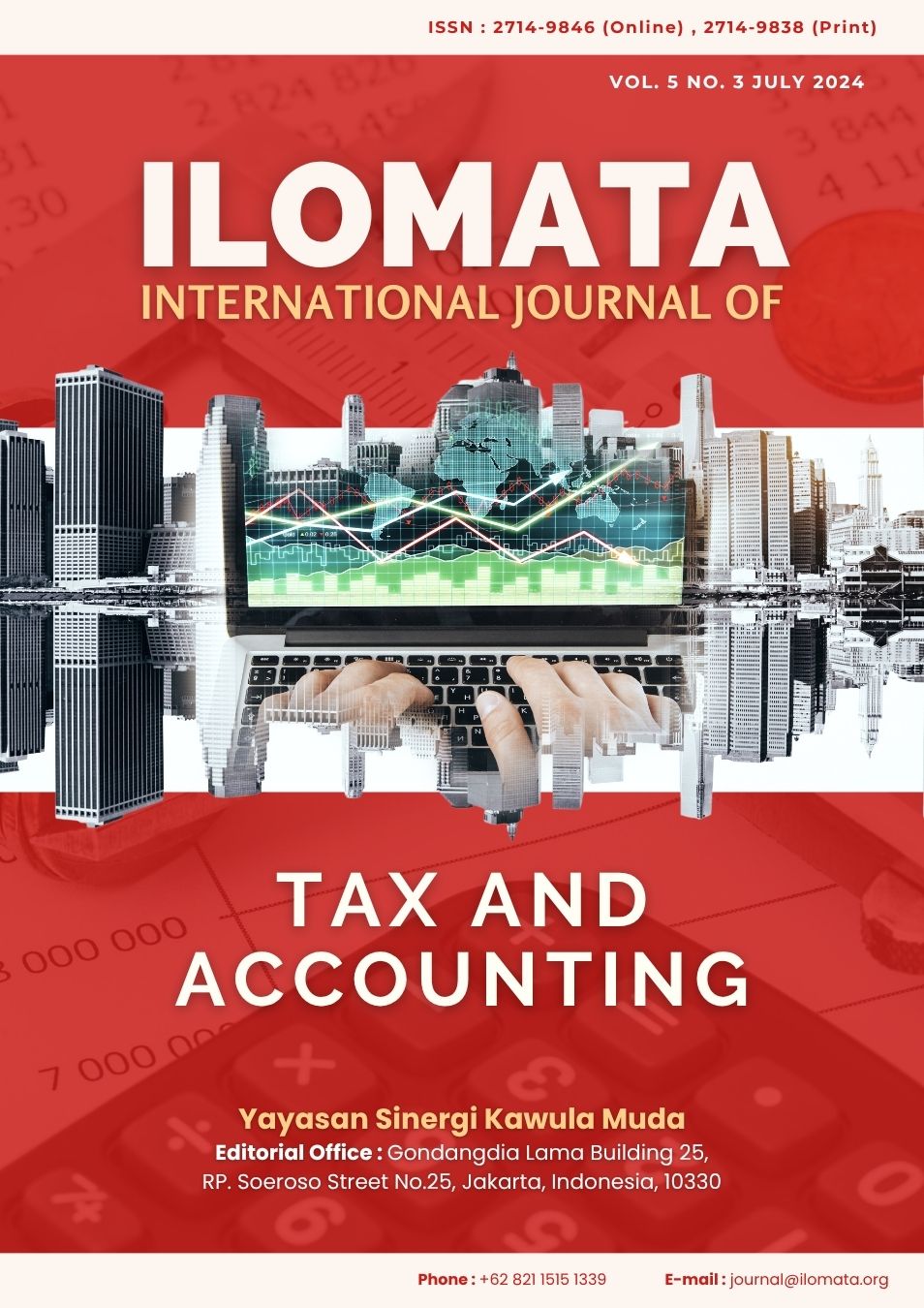Main Article Content
Abstract
Through Tax Reform Volume III, the Directorate General of Taxes (DGT) introduced the Tax Administration Core System (SIAP) or Coretax which aims to revolutionize the tax administration process to increase tax revenue and taxpayer compliance. This study aims to explore changes in the tax intelligence business process, one of the business processes in Coretax. This study is an exploratory study conducted by digging up in-depth information from 14 respondents who are business process owners, users of intelligence reports, and strategic leaders to be then compared with its implementation at the Australian Taxation Office. The study results indicate that the Coretax Application has excellent potential to produce actionable intelligence, namely the results of intelligence activities that are relevant, contextual, and can be used immediately. For this reason, intensive training is needed regarding the application and additional features to increase the effectiveness of the application, data integration to accelerate the exploration of taxpayer potential and ensure the relevance of the information presented, as well as continuous updates to the Coretax Application to face the dynamics of the global economy and technology.
Article Details

This work is licensed under a Creative Commons Attribution 4.0 International License.

This work is licensed under a Creative Commons Attribution 4.0 International License.
References
- Agnes, & et. al. (2021). Literature Review : Analisis Peran Pajak sebagai Upaya Perwujudan Pembangunan. Jurnal Ekonomi, Manajemen, Akuntansi Bisnis Digital, Ekonomi Kreatif, dan Entrepreneur, 2(1), 81-89. doi:https://doi. org/10. 56456/jebdeker. v2i1. 82
- Arbel Y, F. C. (2019). Can the Laffer curve become a policy tool for reducing tax evasion? Stratification of property tax collection by land use. Journal of Urban Management, 8(1), 57-74. doi:https://doi. org/10. 1016/j. jum. 2018. 09. 001
- ATO. (2023, May 14). Australian Taxaxtion Office. Diambil kembali dari https://www. ato. gov. au/: https://www. ato. gov. au/about-ato/commitments-and-reporting/in-detail/privacy-and-information-gathering/how-we-use-data-matching
- ATO. (2024, August 12). Australian Taxation Office. Diambil kembali dari https://www. ato. gov. au/: https://www. ato. gov. au/about-ato/commitments-and-reporting/information-and-privacy/how-we-use-data-and-analytics
- Azuaje, M. J. (2023). Digitisation and/or digital transformation in the field of Tax . Review of International & European Economic Law, 4(2), 1-23.
- Braithwaite, V. , & Braithwaite, J. (2000). Managing taxation compliance: The evolution of the ATO Compliance Model. In Tax Administration in the 21st Century: The Fourth International Conference on Tax Administration to be held by ATAX, 215-24.
- Carter, K. B. (2014). Actionable Intelligence: A Guide to Delivering Business Results with Big Data Fast! John Wiley & Sons.
- Claus I, M. -V. J. (2014). Government fiscal policies and redistribution in Asian countries. In R Kanbur, C Rhee, J Zhuang (eds. ) Inequality in Asia and the Pacific: trends, drivers, and policy implications. Routledge, London, 197–225.
- Creswell, J. W. (2014). Research Design: Qualitative, Quantitative and Mixed Methods Approaches (4th ed. ). Thousand Oaks, CA: Sage.
- Darussalam, Septriadi, D. , Kristiaji, B. , & Vissaro, D. (2019). Era Baru Hubungan Otoritas Pajak dengan Wajib Pajak. Jakarta: DDTC.
- DJP. (2019). Peraturan Direktur Jenderal Pajak Nomor PER-15/PJ/2019 tentang Pelaksanaan Kegiatan Intelijen Perpajakan dan Pengamatan. Jakarta: Direktorat Jenderal Pajak.
- DJP. (2022). CRMBI: Langkah Awal Menuju Data Driven Organization. Direktorat Jenderal Pajak.
- DJP. (2023). Reformasi Administrasi Pajak dari Masa ke Masa. Jakarta: Direktorat Jenderal Pajak.
- Enache, C. (2020). Sources of Government Revenue. Fiscal Fact, 695.
- Gao, Z. , Lu, L. Y. , & Yu, Y. (2019). Local Social Environment, Firm Tax Policy, and Firm Characteristics. Journal of Business Ethics, 158, 487–506.
- Granger, J. , & Sawyer, A. (2022). Digitally prepared?: The journeys of the revenue administrations in Australia and New Zealand. Taxation in the Digital Economy, 166-190.
- Kemenkeu. (2021). Peraturan Menteri Keuangan Republik Indonesia Nomor 118/PMK. 01/2021 tentang Organisasi dan Tata Kerja Kementerian Keuangan. Jakarta: Kementerian Keuangan Republik Indonesia.
- Kemenkeu. (2023). Informasi APBN 2023: Peningkatan Produktivitas untuk Transformasi Ekonomi yang Inklusif dan Berkelanjutan. Jakarta, Indonesia: Kemenkeu.
- Kementerian Keuangan. (2020). Keputusan Menteri Keuangan Nomor 130/KMK. 03/2020 tentang Pembentukan Tim Pembaruan Sistem Inti Administrasi Perpajakan (PSIAP).
- Kusuma, I. G. , & Maradona, A. F. (2020). Peran Intelijen Perpajakan dalam Meningkatkan Penerimaan Pajak. E-JURNAL AKUNTANSI, 30(No. 8), 1957-1968.
- Lowenthal, M. M. (2022). Intelligence: From Secrets to Policy. CQ Press.
- Meiryani, Oktavianie, H. , & Teresa, V. (2022). Understanding Determinants of Computer Assisted Audit Techniques (CAATs) Adoption Intention Among Auditors in Indonesia. ICIEB 2022: 2022 3rd International Conference on Internet and E-Business. doi:10. 1145/3545897. 3545915
- OECD. (2020). Digital government in Mexico: Sustainable and inclusive transformation. Paris: OECD Publishing.
- Ovcharova, E. &. (2019). OvchTax Compliance in the Russian Federation, the United Kingdom of Great Britain and Northern Ireland, and the United States of America: Forcing and Encouraging Lawful Conduct of Taxpayers. Ovcharova, Elena & Tasalov, Kirill & Osina, Dina. (2019). Tax Compliance in the Russian Federation, the United Kingdom of Russian Law Journal, 4-54.
- Roscoe, J. T. (1975). Fundamental research statistics for the behavioral sciences (Second ed. ). New York: Holt Rinehart and Winston.
- Saragih, A. H. , & et. al. (2023). The potential of an artificial intelligence (AI) application for the tax administration system’s modernization: the case of Indonesia. Artificial Intelligence and Law; Dordrecht, 491-514.
- Sentanu, S. (2016). PENGARUH KUALITAS PELAYANAN, KEWAJIBAN MORAL DAN SANKSI PERPAJAKAN PADA KEPATUHAN WAJIB PAJAK HOTEL. E-Jurnal Akuntansi, 16(1), 306-332.
- Ullah, F. , Sepasgozar, S. , Thaheem, M. J. , & Al-Turjman, F. (2021). Barriers to the digitalisation and innovation of Australian Smart Real Estate: A managerial perspective on the technology non-adoption. Environmental Technology & Innovation, 22(1). doi:10. 1016/j. eti. 2021. 101527
- Zakaria, M. , & et. al. (2024). Adoption of tax digitalisation among Malaysian tax practitioners. TELKOMNIKA; Yogyakarta, 22(3), 567-575. doi:10. 12928/TELKOMNIKA. v22i3. 25959
- Zhang, Q. , & She, J. (2024). Digital transformation and corporate tax avoidance: An analysis based on multiple perspectives and mechanisms. PLoS ONE, 19(9), 1-30. doi: https://doi. org/10. 1371/journal. pone. 0310241

